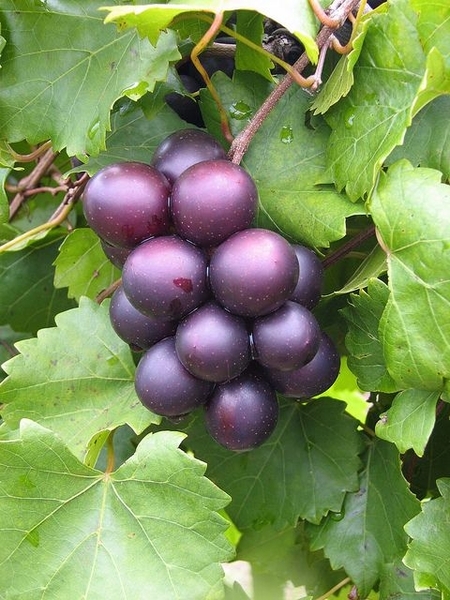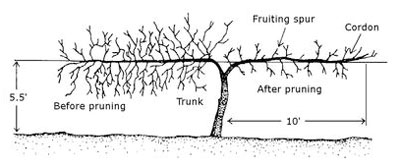While children are having fun growing, harvesting, and eating delicious, nutritious, fresh fruits and vegetables, they also become stewards of the environment and develop healthy life skills.
Muscadine grapes, a native North Carolina treasure, are easy to grow and bursting with flavor and nutrients. The deep purple and bronze-toned fruit clusters can be eaten fresh or dried in jelly, juice, pies, and smoothies, delighting the taste buds of children and adults alike. They are well adapted to a hot, humid climate and tolerate many insect pests and diseases. They can be found growing wild from Delaware through Texas, in swamplands, sandy ridges, and open or forested areas.
Cultivar Selection
Choosing a cultivar known to thrive in this climate increases your likelihood of success.
- Bronze: ‘Darlene’, ‘Doreen’, ‘Fry’, ‘Granny Val’, ‘Magnolia’, ‘Triumph’
- Early Fruiting Bronze: ‘Jumbo’, ‘Scarlett’, ‘Summit’, ‘Supreme’, ‘Sweet Jenny’, ‘Tara’
- Red: ‘Alachua’, ‘Nesbitt’, ‘Welder’
For more information on cultivar selection, see Muscadine Grapes in the Home Garden.
Plant
Site Selection and Preparation
- Full sunlight, or least 6 hours a day.
- Well-drained soil that prevents standing water near the roots is essential.
- Soil amendments: To learn how to submit a soil sample for analysis, watch this short video, How to Test Your Garden Soil, or review soil testing instructions from Extension Gardening. The personalized report that you receive will provide specific recommendations for amendments including fertilizer and lime.
- Muscadines prefer acidic soil with a pH level between 5.8 and 6.5. If needed, the soil test report may recommend amending the soil with dolomitic lime.
- Minimizing Risks of Soil Contaminants in Urban Gardens, NC State Extension publication AG-439-78
- Complete the Check Your Dirt NC survey to get specific information relevant to your garden.
For more information on planting muscadines, see Muscadines Grapes in the Home Garden.
Timing
- Plant in the spring.
Spacing
- Plant 10 to 20 feet apart.
- Support with a trellis, arbor, chain link fence, or vertical structure. Muscadine vines can provide shade when trained over a pergola, but this strategy requires careful pruning or fruit production may decline. A simple trellis can be two posts set 10 to 20 feet apart with a single wire, 5 to 6 feet above the ground, running between posts and anchored firmly at each end.
- Dig a hole that is twice as wide as the root system and as deep as the root ball. Rough up the sides of the hole with your hands or a trowel. Cut off any damaged roots or roots that are too long to fit in the hole. After you have planted the vine, fill the hole back up with native soil, and water the area well.
Mulching
- Apply a 4- to 6-inch-deep layer of organic mulch 4 feet wide under the wires connecting the posts.
Management
Watering
- Muscadine grapes are quite drought-tolerant. Water during dry periods for the first two years, after which the vines can usually obtain adequate water from the soil, even during dry periods.
Fertilizer
- More is not better. Over-fertilizing can lead to poor fruit quality, excessive growth, and increased vulnerability to frost damage. Lightly fertilize with nitrogen, phosphorus, or potassium, but only if recommended in soil test results; do not apply late in the fall as this will make the vines more prone to winter injury. Fertilize based on the recommendations in the soil test report.
Pruning
Vines have a trunk, permanent arms (cordons), and fruiting spurs (branches that bear fruit).
- After planting, prune to one stem and cut this stem back to two or three buds.
- When new growth begins, select the most vigorous shoot and remove the others.
- Loosely tie the shoot to a bamboo-training stake. Continue tying the vine and removing side shoots each week.
- When the vine is just below the wire, cut the growing tip to force buds. Shoots from the lateral buds should be trained down the wire to form the cordons.
- After the cordon has developed to full length, cut the side shoots back to two or three buds during the dormant season. Next season, the buds on these side shoots will develop into shoots that produce flowers and fruit.
- Each dormant season, cut the lateral shoots back to two or three buds.
For more information on caring for muscadines, see Muscadine Grapes in the Home Garden.
Harvest
- Harvest: Early August to September.
- Average Pounds of Fruit per Vine per Year: 46 pounds
- Eating: The entire muscadine fruit is delicious and nutritious. Some people eat the whole berry — skins, seeds, and pulp. Others prefer to squeeze the skin and pop the pulp into their mouth, discarding the skins. Still, others like to spit the seeds out and only eat the pulp.
Troubleshooting Common Problems
Weather
- Early and late frosts are the greatest risk to muscadines. Refer to the Extension Gardening page of Average First and Last Frost Dates for your location. Vines are most susceptible to late frosts in the spring. Unfortunately, little can be done to protect the blossoms. Frosts can also damage new growth.
Weeds
- Weeds compete with the plant for water and nutrients. Remove all vegetation underneath the vines and maintain a 3-to-4-inch-deep layer of mulch. Avoid using hoes, weed trimmers, or tillers under the vines as they could harm roots near the surface and damage the vine.
Fun with Muscadines
Videos
“Meet the Muscadine: The Grape of the South.” NC State Extension: Homegrown. September 8, 2019. Video.
Resources
- NC State Extension Horticulture
- Muscadine Grapes in the Home Garden
- Muscadine Portal
- Garden Help Directory — Contact the local N.C. Cooperative Extension center in your county.
Acknowledgments
Funding for this publication was provided in part by the John Rex Endowment.
The authors would like to thank Melissa Bell, Research Associate, Center for Environmental Farming Systems Field Research, Education and Outreach Liaison, NC State University, for their management of the review process.
This publication was developed in partnership with the Natural Learning Initiative in the College of Design at North Carolina State University.
About the Local Foods Series: Childcare Center Production Gardens
This publication in the Local Foods series is one of 15 publications about childcare center production gardens:
- Growing and Cooking Fruits and Vegetables at Childcare Centers (LF-007-01)
- Creating Childcare Center Production Gardens (LF-007-02)
- Growing Warm-Season Fruits and Vegetables in Childcare Production Gardens (LF-007-03)
- Growing Cool-Season Vegetables in Childcare Production Gardens (LF-007-04)
- Snacking and Cooking with Warm-Season Produce from Childcare Production Gardens (LF-007-05)
- Snacking and Cooking with Cool-Season Produce from Childcare Production Gardens (LF-007-06)
- Composting in Childcare Center Production Gardens (LF-007-07)
- Vermicomposting in the Childcare Center Production Gardens (LF-007-08)
- Introducing Children to Insects in Childcare Center Gardens (LF-007-09)
- Easy Fruits to Grow at Childcare Center Gardens (LF-007-10)
- Growing Strawberries in Childcare Center Gardens (LF-007-11)
- Managing Weeds in Childcare Center Gardens (LF-007-12)
- Growing Fruit Trees in Childcare Center Gardens (LF-007-13)
- Growing Muscadines in Childcare Center Gardens (LF-007-14)
- Growing Blueberries in Childcare Center Gardens (LF-007-15)
Publication date: July 27, 2023
LF-007-14
N.C. Cooperative Extension prohibits discrimination and harassment regardless of age, color, disability, family and marital status, gender identity, national origin, political beliefs, race, religion, sex (including pregnancy), sexual orientation and veteran status.




